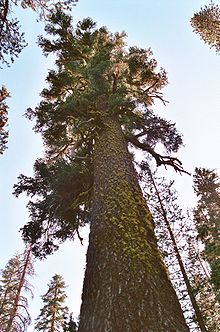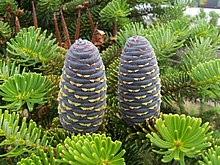|
Fir
Firs are evergreen coniferous trees belonging to the genus Abies (Latin: [ˈabieːs]) in the family Pinaceae. There are approximately 48–65[3][4] extant species, found on mountains throughout much of North and Central America, Eurasia, and North Africa. The genus is most closely related to Keteleeria, a small genus confined to eastern Asia.[5] The genus name is derived from the Latin "to rise" in reference to the height of its species.[6] The common English name originates with the Old Norse fyri or the Old Danish fyr.[7] They are large trees, reaching heights of 10–80 metres (33–262 feet) tall with trunk diameters of 0.5–4 m (1 ft 8 in – 13 ft 1 in) when mature. Firs can be distinguished from other members of the pine family by the way in which their needle-like leaves are attached singly to the branches with a base resembling a suction cup, and by their cones, which, like those of cedars, stand upright on the branches like candles and disintegrate at maturity. Identification of the different species is based on the size and arrangement of the leaves, the size and shape of the cones, and whether the bract scales of the cones are long and exserted, or short and hidden inside the cone. DescriptionLeaves
Firs can be distinguished from other members of the pine family by the unique attachment of their needle-like leaves to the twig by a base that resembles a small suction cup. The leaves are significantly flattened, sometimes even looking like they are pressed, as in A. sibirica. The leaves have two whitish lines on the bottom, each of which is formed by wax-covered stomatal bands. In most species, the upper surface of the leaves is uniformly green and shiny, without stomata or with a few on the tip, visible as whitish spots. Other species have the upper surface of leaves dull, greyish green or bluish to silvery (glaucous), coated by wax with variable number of stomatal bands, and not always continuous. An example species with shiny green leaves is A. alba, and an example species with matt waxy leaves is A. concolor. The tips of leaves are usually more or less notched (as in A. firma), but sometimes rounded or dull (as in A. concolor, A. magnifica) or sharp and prickly (as in A. bracteata, A. cephalonica, A. holophylla). The leaves of young plants are usually sharper. The leaves are arranged spirally on the shoots, but by being twisted at their base, the way they spread from the shoot is diverse; in some species comb-like ('pectinate'), with the leaves flat on either side of the shoot (e.g. A. alba, A. grandis), in others, the leaves remain radial (e.g. A. pinsapo)[8] Foliage in the upper crown on cone-bearing branches is different, with the leaves shorter, curved, and sometimes sharp.[9] Cones
Firs differ from other conifers in having erect, cylindrical cones 5–25 cm (2–10 in) long that disintegrate at maturity to release the winged seeds. In contrast to spruces, fir cones are erect; they do not hang, unless heavy enough to twist the branch with their weight. The mature cones are usually brown. When young in summer, they can be green: or reddish: or bloomed pale glaucous or pinkish: or purple to blue, sometimes very dark blue, almost black: Many species are polymorphic in cone colour, with different individuals of the same species producing either green or purple cones:
The cone scale bracts can be short and hidden in the mature cone, or long and exposed ('exserted'); this can vary even within a species, e.g. in Abies magnifica var. magnifica, the bracts are hidden, but in var. critchfieldii and var. shastensis, they are exserted. The bracts scales are often a different colour to the cone scales, which can make for a very attractive combination valued in ornamental trees. ClassificationThe oldest pollen assignable to the genus dates to the Late Cretaceous in Siberia, with records of leaves and reproductive organs across the Northern Hemisphere from the Eocene onwards.[10]
Section AbiesSection Abies is found in central, south, and eastern Europe and Asia Minor.
Section BalsameaSection Balsamea is found in northern Asia and North America, and high mountains further south.
Section GrandisSection Grandis is found in western North America to Mexico, Guatemala, Honduras and El Salvador, in lowlands in the north, moderate altitudes in south.
Section MomiSection Momi is found in east and central Asia and the Himalaya, generally at low to moderate altitudes.
Section AmabilisSection Amabilis is found in the Pacific Coast mountains in North America and Japan, in high rainfall areas.
Section Pseudopicea Section Pseudopicea is found in the Sino – Himalayan mountains at high altitudes.
Section OiamelSection Oiamel is found in central Mexico at high altitudes.
Section Nobilis Section Nobilis (western U.S., high altitudes)
Section BracteataSection Bracteata (California coast)
Section Incertae sedisSection Incertae sedis
EcologyFirs are used as food plants by the caterpillars of some Lepidoptera species, including Chionodes abella (recorded on white fir), autumnal moth, conifer swift (a pest of balsam fir), the engrailed, grey pug, mottled umber, pine beauty and the tortrix moths Cydia illutana (whose caterpillars are recorded to feed on European silver fir cone scales) and C. duplicana (on European silver fir bark around injuries or canker). Abies religiosa (sacred fir) trees give roosting shelter to overwintering monarch butterflies.[15][16] PhytochemistryAbies produce a variety of terpenoids. The analyses of the Zavarin group – from Smedman et al. 1969 to Zavarin et al. 1977 – showed variation in terpenoid composition of the bark by genetics, geography, age and size of the tree.[17][18] Uses Wood of most firs is considered unsuitable for general timber use and is often used as pulp or for the manufacture of plywood and rough timber. It is commonly used in Canadian Lumber Standard graded wood.[19] Because this genus has no insect or decay resistance qualities after logging, it is generally recommended in construction purposes for indoor use only (e.g. indoor drywall on framing). Firwood left outside cannot be expected to last more than 12 to 18 months, depending on the type of climate it is exposed to. Caucasian fir, noble fir, Fraser's fir and balsam fir are popular Christmas trees, generally considered to be the best for this purpose, with aromatic foliage that does not shed many needles on drying out. Many are also decorative garden trees, notably Korean fir and Fraser's fir, which produce brightly coloured cones even when very young, still only 1–2 m (3 ft 3 in – 6 ft 7 in) tall. Many fir species are grown in botanic gardens and other specialist tree collections in Europe and North America.[20] Abies spectabilis or Talispatra is used in Ayurveda as an antitussive (cough suppressant) drug.[21][22] See alsoReferences
Further reading
External linksWikimedia Commons has media related to Abies.
|
|||||||||||||||||||||||||||||||||||||||||||||||||||||||||||||||||||||||||||||||||||||||||||||||||||||||||||||||||||||||||||||||||||||||||||||||||||||||||||||||||||||||||||||||||||||||||||||||||||||||||||||||||||||||||||||||||||||||||||||||||||||||||||||||||||||||||||||||||||||||||||||||||||||||||||||||||||||||||||||||||||||||||||||||||||||||||||||||||||||||||||||||||||||










